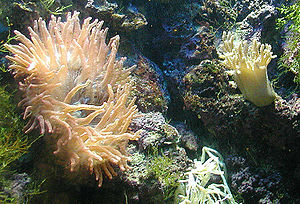Coelenterates
| Coelenterates | ||||||||||
|---|---|---|---|---|---|---|---|---|---|---|
|
Obsolete systematic group The taxon dealt with here is not part of the systematics presented in the German-language Wikipedia. More information can be found in the article text. |
||||||||||

Sea anemone (left) and soft coral (right). |
||||||||||
| Systematics | ||||||||||
|
||||||||||
| Scientific name | ||||||||||
| Coelenterata | ||||||||||
| Linnaeus , 1758 | ||||||||||
The hollow animals (Coelenterata) form one of the three organizational levels within the tissue animals (Eumetazoa) living in the water . They include the two animal phyla, the cnidarians (Cnidaria) and the comb jellyfish (Ctenophora). Both have in common the more or less radially symmetrical body shape, a diffuse nerve network (network nervous system) and the basic structure of only two cell layers epidermis and gastrodermis, which is why one speaks of diploblastic animals. In both animal groups there is a gelatinous zone between these two cell layers, the so-called mesenchyme (mesogloea).
Hollow animals in the system
Classic system
The hollow animals traditionally represent a trunk or, alternatively, an overstem that combines the two taxa cnidarians (Cnidaria) and rib jellyfish (Ctenophora) , which are now regarded as animal phyla.
| Tissue animals (Eumetazoa) |
|
||||||||||||
|
|
Phylogenetic systematics
Today the coelenterates are no longer considered to be a natural relatives group, since the named commonalities are not regarded as synapomorphies , common derived features, but as primitive features, which therefore may not be used for classification. Instead, there is agreement that the closest relatives of the comb jellyfish are the mirror-symmetrical Bilateria . The cnidarians are regarded as the sister group of this group, then called Acrosomata. This group is called because of the uniform structure of the acrosome in comb jellyfish and bilateria , a cap-shaped structure at the tip of the sperm , which initiates fertilization on contact with an egg cell. Essential for this are the enzymes stored in acrosomal vesicles, small organelles bounded by the membrane, which contribute to the local dissolution of the egg shell. Cnidarians and sponges (Porifera) have several small acrosomal vesicles, but comb jellyfish and bilateria have a large one.
| Tissue animals (Eumetazoa) |
|
||||||||||||
|
|
Reproduction
In most coelenterates, there is a generation change during reproduction . A cycle is therefore only completed after an asexual and a sexual increase.